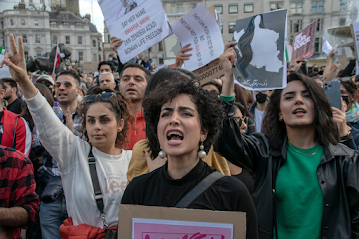Women are chafing against intrusive restrictions. Young women and men worry about lack of opportunities and well-paying jobs, making marriage difficult. Resentment is on the rise and the regime faces a rocky ride.
The BBC tells us that
women around the world are now cutting their
hair to show their solidarity with their Iranian counterparts. Abir Al-Sahlani,
a Swedish Member of the European Parliament, cut her hair in the midst of her
speech, giving a rallying cry: “women, life, freedom.”
Why are
women protesting?
Since 1979, Shia clerics
have ruled Iran. They have imposed strict moral codes and restrictive rules on
society. Women are supposed to dress modestly and cover their hair in
accordance with clerics’ strict interpretations of Islam. As education levels
increase, Iranian women are increasingly unwilling to play by such rules.
Irshad can stop
and intimidate any woman for the most arbitrary of reasons. Over the years,
Iranian women have become highly educated. The percentage of females in higher
education increased from
3% in 1978 to 59% in 2018. Women have entered almost all professions now. Their
expectations have risen similarly. Even when there have been no protests, there
is a simmering discontent among women about the restrictions they face on a
daily basis. Many women hate the morality police.
So unpopular is irshad that
conservative president Mahmoud Ahmadinejad proposed
to parliament to get rid of this morality police but he was shot down by those
far more conservative than him, led by Parliament’s members Mutahari and
Pizishkiyan. He explained that the police are also young people and they cannot
make a correct diagnosis. Overall, Ahmadinejad opposed forcing
people to observe the hijab rule. He held that people had rights to choose and
they must be given choices so he was accused by ultra-conservatives of
supporting indecency.
While women may have done
well in gaining an education, jobs have been hard to find. Glass ceilings
remain thick and strong. Few women make it to top positions. They also find it
difficult to get married because educated men with good jobs are in short
supply. Furthermore, strict rules make it difficult for women and men to
socialize. Like women elsewhere, Iranian women want some choice when it comes
to their life partners.
Last year, Ebrahim Raisi
was elected president. He is a conservative cleric who has sought to
reinvigorate the old cultural revolution. Irshad have stepped
up patrols and taken women away for “re-education” because of their supposedly
improper dress. A hijab-and-chastity decree bans women without headscarves from
posting pictures of themselves on social media. Naturally, women are
dissatisfied with the tightening of restrictions and Amini’s death has set off
a powder keg.
Why are men protesting?
Not only women but also
men have taken to the streets. If Iranian women are dissatisfied, so are the
men. They are really frustrated with the lack of opportunities. Many have lost
hope in the future. In particular, educated men are most discontented. They are
unable to get decent well-paying jobs. This restricts their marriage
opportunities.
Young people are
increasingly influenced by western media. They think of the US as a land of
milk and honey. Alumni of the elite Sharif University of Technology leave the
country in the search of a better life. Those who remain behind are frustrated
by the lack of jobs in Iran. They access western media and want similar
lifestyles to what they see on screen. This exacerbates their discontent.
American sanctions have
taken their toll on the Iranian economy. Since 2012, per capita income has
stagnated. After the Russia-Ukraine War, inflation has further soared. To make
matters worse, Iran is facing an environmental crisis. Rivers have run dry,
groundwater is falling, lakes are drying up and farmland is parched. A growing
population has led to wanton felling of forests. In turn, deforestation has exacerbated
desertification. As in India and China, pollution is choking cities. Young men
find it very difficult to be hopeful about the future.
Over 60% of Iran’s 84
million population is under 30. Historically, young single men have been a
source of instability in any society. Iran has millions of discontented young
men. During the recent protests, unknown assailants have attacked banks,
police, ambulances, other government officials, mosques, clerics and religious
people. The 1979 revolution may not yet be at risk but Iranian society is
volatile and could erupt in a volcanic eruption given the slightest
provocation.
This article was
originally published on Fair
Observer on October 15,
2022.














